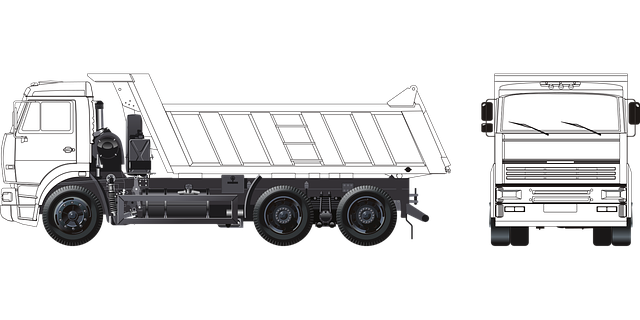Looking to register your car in California? This comprehensive guide walks you through every step, from understanding key requirements for car registration in the Golden State to completing the DMV registration process. We’ll highlight the importance of DMV VIN verification and provide a checklist of necessary documents and vehicle preparations. By following these steps, you’ll be on your way to securing your California vehicle registration efficiently.
- Understand the Requirements for Car Registration in California
- Gather Necessary Documents for DMV Vin Verification
- Prepare Your Vehicle for Inspection and Title Transfer
- Complete the DMV Registration Process Step-by-Step
- Finalize and Obtain Your California Vehicle Registration Papers
Understand the Requirements for Car Registration in California

Before registering your car in California, it’s crucial to understand the requirements set by the Department of Motor Vehicles (DMV). To start, all vehicles must undergo a DMV vin verification process, which involves confirming the vehicle’s unique identifier, known as the Vehicle Identification Number (VIN), and ensuring it matches the make, model, and year listed on the title. This step is vital to prevent fraud and ensure the accuracy of registration records.
Additionally, you’ll need to meet specific criteria like having a valid driver’s license, providing proof of insurance, and paying the required registration fees. Some vehicles may also require additional inspections, such as mobile VIN inspection for certain models or types, to comply with state safety standards. Ensuring these requirements are met will streamline the car registration process in California.
Gather Necessary Documents for DMV Vin Verification

Before you can register your car in California, you’ll need to undergo a crucial step: DMV VIN verification. This process involves ensuring that your vehicle’s unique identifier, the Vehicle Identification Number (VIN), matches the details on record with the Department of Motor Vehicles (DMV). To facilitate this, gather all necessary documents, including your car’s title, registration papers, and proof of insurance. Additionally, you may want to have a mobile VIN verification done by a trusted service—a convenient option that allows a professional to inspect your vehicle remotely using advanced technology, providing an accurate report in no time.
For a seamless experience, ensure all documents are up-to-date and complete. This includes the vehicle’s title, which should be signed and reflect your ownership status. A mobile VIN inspection can further aid in this process by offering a detailed, digital report of your car’s condition, making it easier to address any discrepancies before heading to the DMV for final registration.
Prepare Your Vehicle for Inspection and Title Transfer

Before heading to the DMV for registration, ensure your vehicle is prepared for the inspection process. This includes having all necessary documents in order and making sure your car is safe to drive. One crucial step is to obtain a Vehicle Identification Number (VIN) verification, which can be done through a mobile VIN verifier or inspection service. These services provide a convenient way to check your vehicle’s history and ensure it meets the state’s safety standards.
During the preparation phase, double-check that your car’s registration papers are updated and include accurate information. The DMV requires a valid title transfer, so make sure you have all the required documents ready for a smooth transition. Additionally, consider scheduling a mobile VIN inspection to avoid any delays or complications during the registration process.
Complete the DMV Registration Process Step-by-Step

Completing the DMV registration process is straightforward when followed step-by-step. First, gather all necessary documents including your vehicle’s title, proof of insurance, and valid driver’s license. Next, visit a California DMV field office or use their online services for convenient registration. For a seamless experience, conduct a dmv vin verification using the Vehicle Identification Number (VIN). This step is crucial to ensure the vehicle’s history aligns with its current condition.
If you prefer a more flexible approach, consider using a mobile vin verifier or scheduling a vin inspection. These options allow you to complete the VIN verification process at your convenience, further simplifying registration. Once all requirements are met, submit your application and pay the necessary fees. A successful registration will result in a new car title and registration documents, marking a significant milestone in owning your vehicle.
Finalize and Obtain Your California Vehicle Registration Papers

Once you’ve gathered all necessary documents and passed the DMV vehicle inspection (including a thorough DMV VIN verification), it’s time to finalize your California vehicle registration. You’ll need to obtain your official California Vehicle Registration Papers, which confirm that your car is legally registered in the state. This crucial step ensures that you’re compliant with local laws and helps protect both you and other drivers on the road.
To get these papers, submit all required forms, along with any applicable fees, at a nearby California DMV office. Alternatively, many counties offer the option of obtaining registration online or through a mobile VIN inspection service, which allows for greater convenience. Some even provide the ability to use a mobile VIN verifier, streamlining the process and making it accessible from the comfort of your home.
Registering a car in California involves several straightforward steps, from understanding the requirements to completing the DMV registration process. By gathering necessary documents for DMV VIN verification and preparing your vehicle for inspection and title transfer, you’re well on your way to securing your California vehicle registration papers. Remember to stay organized, double-check all details, and follow each step diligently for a smooth and successful registration experience.
